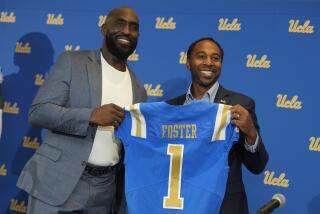Small Patch Could Mean Big Money to Athletic Programs
- Share via
Are they selling out or seizing an opportunity? That’s one of the ethical dilemmas facing educators who hope to adequately fund high school athletics. The issue that causes that dilemma centers on a small piece of cloth with Toyota, Reebok or some other corporate name on it.
And it may well make it onto the high school uniform within a decade--maybe even this decade.
The California Interscholastic Federation made its pitch for the patch in January, 1994, when it proposed a resolution to the National Federation of High School Assns.--the national governing body for high school sports--to allow a 2-by-3-inch logo, mark or insignia, specifically approved by each state association, on the shoulder or hip of uniforms, in addition to the 1 1/2-by-1 1/2-inch manufacturer’s logo.
The proposal needed a majority of the 51 votes to pass; it received 15. But Margaret Davis, CIF associate commissioner, is optimistic because the patch is now on the national agenda.
“Because of our uniqueness, we face some very difference challenges and we need new solutions. We put out the information, we try to educate people as to what is happening, and it’s always two to three years before (it) hits the rest of the country,” Davis said. “It’s not surprising that some of our ideas don’t have instant acceptance.
“California is often the forerunner to what happens in the rest of the country.”
There are some practical applications for such a patch. For example, the CIF could use it to launch a statewide campaign promoting secondary education, sobriety or sportsmanship--i.e. “College Bound,” “Don’t Drink and Drive, “Let’s Be Better Sports”--and include the sponsor’s name on it.
For example, Toyota, which is paying $500,000 annually to the CIF to be its official sponsor of high school athletics would get its name on the patch. The value to the company should rise significantly if virtually every photo of a high school athlete included Toyota in it.
But there are no sure bets that this is a great idea.
“Our CIF sponsorship is not totally altruistic, it’s part philanthropy, part exposure,” said Jim Olson, Toyota’s group vice president of external affairs. “If we want, we get to put Toyota banners at any game we want to, and Toyota’s name goes on the trophies at the state and regional levels. We hope that the parents know we’re supporting the CIF, but a lot of it is philanthropic; I’m not sure Toyota would be comfortable doing with high school kids what we do with professional golfers.
“Maybe this is inevitable, but I’m not sure I want Toyota to be the first one to have its name on a high school jersey.”
Under California’s proposal, each state association would have control of the patch--or if it even allowed a patch. California, Davis said, would probably prevent individual schools from doing their own marketing. Taco Bell, for example, could not become the official sponsor of Mater Dei or Marriott hotels link up with Brea Olinda.
The reasons for that are apparent: The stronger programs would get sponsors, the weaker programs would not.
Helen Upton, the assistant director of the national federation, asks some obvious questions: “When schools are so dependent on their sponsorships, what happens if they don’t do well? Do they lose that sponsorship? Or what happens when corporations change their marketing plans? Or what will the corporations, or the schools, do to ensure their school gets back on top?”
Corporations have been angling for basketball, and that’s why basketball has its specific language requiring a clean uniform with the exception of the American Flag--because it has previously faced the question.
But national rules don’t address the question of sponsor advertising on uniforms, with the exception of swimming and basketball--which explicitly do not allow it. State associations provide direction for their member schools as it relates to using any kind of logo; because national rules were unclear related to uniform attachment on non-basketball and swimming uniforms, the California Federated Council adopted a rule over the weekend prohibiting use of any additional attachments until it makes a permanent statewide ruling.
California’s proposal from a year ago would have allowed states to pick up basketball, but Upton said the lack of support may not have been only because states were anti-advertising. They may have been against reversing basketball’s and swimming’s rules, and not allowing the other sports rules committees an opportunity to consider its impact.
Not everyone likes the idea of even a simple corporate message on a state-sponsored patch. Tom Triggs, Buena Park principal and president-elect of the Southern Section Council and an Executive Committee member, said corporate sponsorship assists all sections, but athletics shouldn’t go overboard. “Every time you look, you see some representation from some fast food or whatever,” Triggs said. “This is still a school-sponsored, organized activity and it’s not an arena for the corporate field.”
Still, athletic programs need money, and to put off planning for more visible corporate sponsorship until it is absolutely needed might be waiting too long.
“What is an important need in California is very different from what’s important in North Dakota,” Upton said. “You have to have innovative solutions and answer new problems in new ways. In a couple of years, there may be a different reception to (the California proposal).
“But (educators) also face the reality of ‘We want funding’; in an ideal world, that would come from the citizens in the community to financially back their schools. Because it’s amateur sports, there’s concern about the commercialization of young people; when does private sector support for athletics cross over into exploitation?
“The mission should not be to sell tacos.”
More to Read
Get our high school sports newsletter
Prep Rally is devoted to the SoCal high school sports experience, bringing you scores, stories and a behind-the-scenes look at what makes prep sports so popular.
You may occasionally receive promotional content from the Los Angeles Times.






